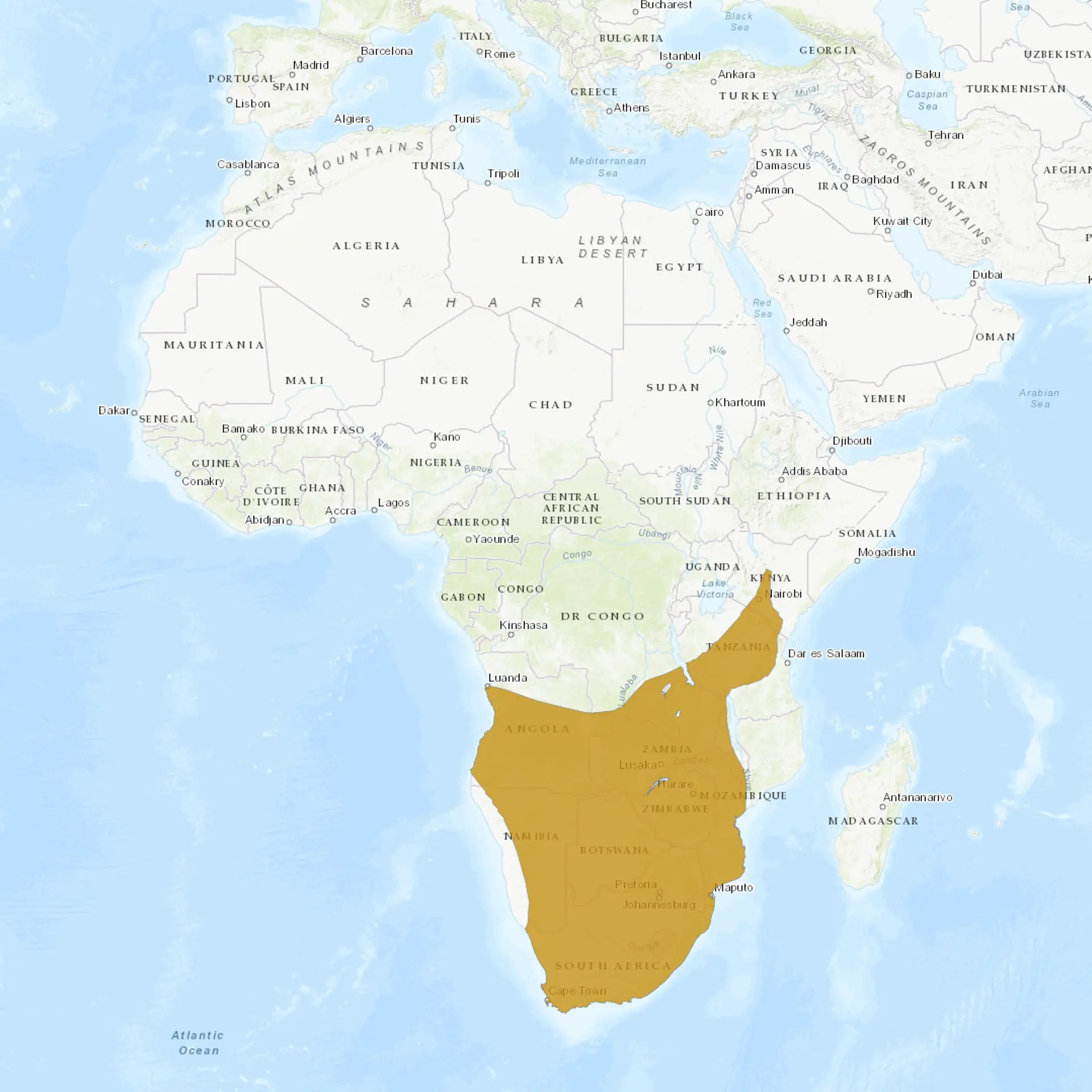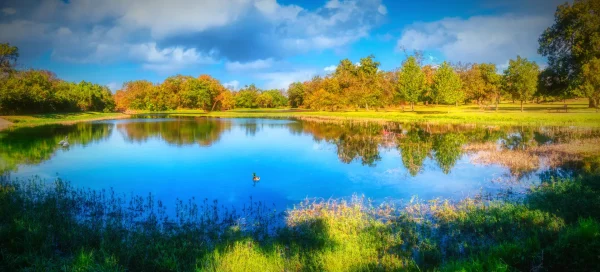Overview
The Blacksmith Lapwing (Vanellus armatus) is a medium-sized bird commonly found in sub-Saharan Africa. It is easily recognizable in its natural habitats because of its striking black, white, and grey plumage. This bird is often seen near water bodies such as rivers, lakes, and marshes, where it forages for food. It derives its name from the metallic, repetitive sound of its call, reminiscent of a blacksmith’s hammer striking an anvil.
Blacksmith Lapwings are highly territorial, especially during the breeding season, aggressively defending their nests against intruders. They are ground-nesters, often laying their eggs in shallow scrapes on bare ground, sometimes adorned with small stones or vegetation. Their diet primarily consists of insects and other small invertebrates, which they pick off the ground or shallow water. These birds are known for their vigilant and protective nature, often alarming other species of potential threats.
The Blacksmith Lapwing is adaptable and has benefited from human alterations to the landscape, such as creating artificial water bodies. It is a resident species throughout its range, although some populations may undertake short migratory movements in response to seasonal water availability. Despite habitat degradation in certain areas, the species remains widespread. Conservation efforts monitor populations and maintain wetland habitats to support their ecological needs.
Taxonomy
Kingdom
Phylum
Class
Order
Family
Genus
Species
Type
Current distribution:
The Blacksmith Lapwing is widely distributed across sub-Saharan Africa, from Senegal and Gambia in the west to Ethiopia, Somalia in the east and southward to South Africa. It is also found in parts of Namibia, Botswana, and Zimbabwe. Populations are stable and widespread, often found in protected and unprotected areas. This bird's range has expanded in some regions due to the creation of artificial water bodies and agricultural development.
The Blacksmith Lapwing is particularly abundant in southern Africa, with significant populations in South Africa, Namibia, and Botswana. Its presence is less common in the more arid regions of southwestern Africa but can still be found near water sources. During the non-breeding season, some populations may move locally in response to changing water levels and food availability. Despite its adaptability, the Blacksmith Lapwing is sensitive to severe habitat destruction, particularly the drainage of wetlands and pollution.
Physical Description:
The Blacksmith Lapwing has a distinctive appearance, with a striking black and white color pattern. The head, throat, and breast are black, contrasting sharply with the white face and belly. The back and wings are grey, with black shoulders and a white stripe running down each wing. Its legs and bill are black, adding to its striking monochrome look.
Adults typically measure about 12–13 inches (30–33 cm) in length, with a wingspan of approximately 27–30 inches (68–76 cm). Both males and females look similar, though females may be slightly smaller. These birds have long legs suited for wading in shallow water, and their sharp, pointed bills are perfect for probing the ground for food. Juveniles appear similar to adults but have more muted, brownish plumage.

Lifespan: Wild: ~10 Years || Captivity: ~20 Years

Weight: Male: 5.6–7.9 oz (160–225 g) || Female: 4.9–7.0 oz (140–200 g)

Length: Male: 12–13 in (30–33 cm) || Female: 11–12 in (28–31 cm)

Height: Male: 12–13 in (30–33 cm) || Female: 11–12 in (28–31 cm)

Wingspan: Male & Female: 27–30 in (68–76 cm)

Top Speed: 30 mph (48 km/h)
Characteristic:
Native Habitat:
Blacksmith Lapwings inhabit various wetland environments, including riverbanks, lake shores, marshes, and floodplains. They are also found in agricultural areas, particularly those with irrigation systems that create suitable feeding grounds. These birds prefer open habitats with low vegetation, which allows them to easily spot predators and other threats. Their adaptability to natural and artificial wetlands has enabled them to thrive in areas impacted by human activity.
They are most commonly found at elevations ranging from sea level to about 3,300 feet (1,000 meters). In some regions, they may also inhabit dry grasslands and savannas, especially during the non-breeding season. Blacksmith Lapwings require access to water for foraging but can tolerate a range of water salinities, from fresh to brackish. Their nesting sites are typically located in open areas near water, ensuring easy access to feeding grounds for adults and chicks.
Biomes:
Biogeographical Realms:
Continents:
Diet:
Diet & Feeding Habits:
The Blacksmith Lapwing is an insectivore that primarily feeds on insects and other small invertebrates. Its diet includes beetles, ants, termites, and various aquatic invertebrates. Foraging is often done in wetland areas, where the bird uses its keen eyesight to spot prey. It employs a systematic approach, walking slowly and picking food from the ground or shallow water.
Blacksmith lapwings may supplement their diet with small amphibians and crustaceans during the breeding season to provide additional nutrients. They have also been observed following large mammals to catch insects disturbed by their movement. The bird’s diet adapts to seasonal changes in food availability, with more reliance on aquatic prey during the wet season. Blacksmith Lapwings are known to feed in agricultural fields, exploiting human-modified landscapes.
Mating Behavior:
Mating Description:
Blacksmith Lapwings are monogamous, forming long-term pair bonds for several breeding seasons. During the breeding season, which typically occurs during the rainy season, males and females engage in elaborate courtship displays. These displays include synchronized flying, vocalizations, and mutual preening to strengthen pair bonds. Once a pair is established, they select and defend a nesting site.
The female lays 2 to 4 eggs in a shallow scrape on the ground, often lined with small stones or vegetation. Both parents share incubation duties, which last about 26 to 28 days. After hatching, the chicks are precocial and leave the nest within a few hours, although they remain under parental care for several weeks. Parents protect their young, aggressively defending them from predators and other threats.
Reproduction Season:
Birth Type:
Pregnancy Duration:
Female Name:
Male Name:
Baby Name:
Social Structure Description:
Blacksmith Lapwings are typically seen in pairs or small family groups, especially during the breeding season. Outside the breeding season, they may form larger flocks, sometimes mixed with other species of wading birds. These flocks provide increased vigilance against predators and facilitate social interactions. The species is known for its loud, metallic calls used to communicate with mates and other group members.
Their territorial behavior is most pronounced when pairs aggressively defend their nesting sites during the breeding season. Both males and females participate in territory defense, using vocalizations and physical displays to deter intruders. Outside the breeding season, territoriality is less intense, and birds are more tolerant of each other’s presence. Social interactions are complex and include various vocal and visual signals to maintain group cohesion and hierarchy.
Groups:
Conservation Status:
Population Trend:
The population of Blacksmith Lapwings is considered stable, with no significant declines reported. The species’ adaptability to various wetland habitats, including those modified by humans, has contributed to its widespread presence. While precise global population numbers are unavailable, the bird is common in sub-Saharan Africa. Monitoring efforts indicate healthy populations in many regions, particularly in southern Africa.
However, localized declines may occur due to habitat destruction and pollution, particularly in areas where wetlands are drained for agriculture or urban development. Conservationists continue to monitor these threats to ensure long-term stability. Efforts are focused on preserving wetland habitats and maintaining the ecological conditions necessary for the species’ survival. In some areas, conservation programs involve the creation of protected wetland reserves to safeguard vital habitats.
Population Threats:
The primary threats to the Blacksmith Lapwing include habitat destruction, particularly the drainage of wetlands for agriculture and urban development. Pollution, such as pesticide runoff and water contamination, also poses significant risks to their foraging grounds. In some regions, human disturbance during the breeding season can lead to nest abandonment and reduced reproductive success. Additionally, climate change and associated changes in water availability may impact wetland habitats, further stressing populations.
Despite these threats, the Blacksmith Lapwing remains resilient due to its adaptability and wide distribution. Conservation measures, including habitat protection and pollution control, are crucial for mitigating these risks. Public awareness and community involvement in wetland conservation can also significantly ensure the species’ continued success. Ongoing research and monitoring are essential to track population trends and address emerging threats.
Conservation Efforts:
Conservation efforts for the Blacksmith Lapwing focus on protecting wetland habitats and maintaining ecological conditions suitable for survival. Many regions have established protected areas and reserves that include important wetland ecosystems. Environmental regulations to reduce pollution and control pesticide use also benefit this species. Conservation organizations work with local communities to promote sustainable land use practices that protect wetland habitats.
Research and monitoring programs are essential to conservation strategies, providing data on population trends and habitat conditions. These efforts help identify critical areas for protection and guide management actions. International cooperation, particularly in regions where the species migrates seasonally, ensures a coordinated approach to conservation. Education and outreach programs raise awareness about the importance of wetland conservation and the role of species like the Blacksmith Lapwing in maintaining ecological balance.
Additional Resources:
Fun Facts
- The Blacksmith Lapwing gets its name from its metallic-sounding call.
- These birds perform distraction displays to protect their nests from predators.
- Blacksmith Lapwings can live up to 20 years in captivity.
- They are highly adaptable and have benefited from creating artificial water bodies.
- Both parents share incubation and chick-rearing duties.
- Chicks leave the nest within hours of hatching but stay under parental care for several weeks.
- They are often found near large mammals, taking advantage of insects disturbed by their movement.
- The species is widespread across sub-Saharan Africa and has a stable population.
- They are known for their vigilant and protective nature.
- Blacksmith Lapwings can tolerate a range of water salinities, from fresh to brackish.
















